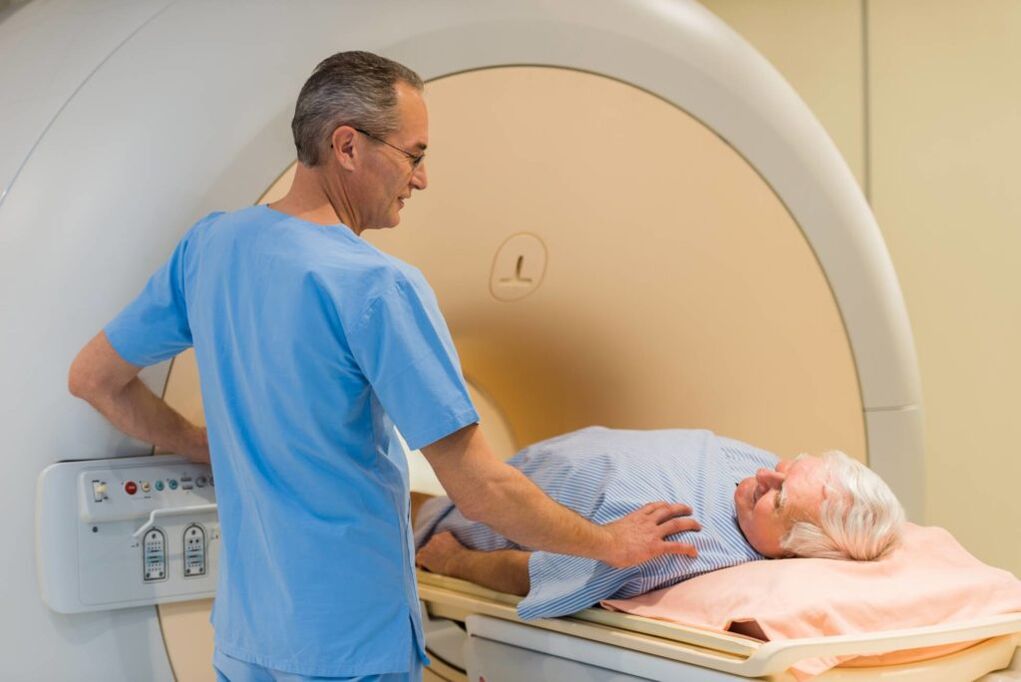Calculitis of the prostate is a complication of the chronic inflammatory process of the prostate gland. With this disease, tartar forms in the secretory channels of the prostate and acin. As a result of the pathological process, the patient's urinary frequency becomes more frequent, there is pain in the perineum and lower abdomen, and the erection deteriorates. You should not run through this disease because it can eventually lead to many health problems.
What is calculated prostatitis

This disease is a form of chronic prostatitis. The disease is characterized by the formation of prostatolytes or tartar, which is one of the most common consequences of prolonged inflammatory processes in the prostate gland.
Stones in the prostate are most commonly found in routine scans in about 9% of men of all ages.
There are three age peaks in the incidence of this form of prostatitis:
- They are 30-39 years old. The disease is not usually detected in patients under 30 years of age. However, the disease gradually recovers. The development of calculous prostatitis in individuals in this age group is associated with a long course of chronic prostatitis caused by gonorrhea, chlamydia, ureaplasmosis or mycoplasmosis.
- They are 40-59 years old. In men in this age group, the disease is most commonly caused by prostate adenoma.
- Over 60 years. In this case, calculous prostatitis is most often caused by the extinction of sexual function.
Causes and risk factors
The formation of stones in the prostate gland can occur for two reasons:
- True or primary, characterized by the direct development of the disease in the glandular or acinar ducts.
- Secondary or false, in which tartar migrates from the upper urinary tract. The most common site of formation is the bladder, kidneys, or urethra. Urolithiasis may be the cause of inflammatory prostatitis.
Depending on the nature of the disease, the causes are divided into two groups:
- Exogenous. In this case, we are talking about factors that are not related to the work of the body but affect it from the outside. These include drug addiction, smoking, or alcohol abuse.
- Endogenous. Concretions occur in the background of disturbances in the functioning of the organization. We talk about organ injuries or complications after surgery. Bacterial damage to the prostate is also associated with these factors.

Alcohol abuse can trigger the development of calculous prostatitis in men.
Calculitis of the prostate usually develops against the background of stagnant, inflammatory lesions of the prostate. Such processes are caused by insufficient emptying of the prostate glands, so the following are the main causes of the disease:
- lack of regular sex life;
- the predominance of a sedentary lifestyle;
- replacing sex with masturbation;
- bad habits such as alcoholism or smoking;
- inflammatory processes in the prostate caused by the penetration of microbes into the organ.
Experts distinguish two main pathological mechanisms that lead to the formation of stones in the organ and its channels:
- Impairment of secretory function resulting in significant stagnation of prostate secretion.
- Throwing of urine into the cavity of the prostate gland. This can be due to the improper functioning of the urinary system, the formation of fistulas and a number of other negative factors.
Symptoms
The signs of calculous prostatitis are in many ways similar to the development of chronic inflammation of the prostate, but more pronounced. Most patients with this form of prostatitis complain of difficulty urinating and pain.
The difference from chronic prostatitis in this case is the pain in the patient day and night, and not just at night. The most common cause of such a clinical picture is a disorder of the outflow of urine and prostate secretions. This is due to complete or partial blockage of the channel with stone.
Several other symptoms of the disease should also be highlighted:
- Presence of pain in the pelvis and perineum. Moreover, they can not only occur while urinating. Patients experience discomfort in the tailbone and lower abdomen that is independent of the time of day.
- Abnormal impurities appear in the sperm. It often has a bloody discharge and can only be pus in extreme cases.
- Painful urination in the background of common false desires. Most patients pass very little urine. However, it may be completely missing.
- Erectile dysfunction. Due to the blockage of the duct of the prostate gland, the normal outflow of sperm from the organ is interrupted. All this leads to the impossibility of ending intercourse.
In the most severe cases of the disease, the patient may have a complete lack of erection and a significant decrease in libido.
Diagnostics

Magnetic resonance imaging provides good results for accurate disease identification.
The patient should be examined thoroughly before treating calculous prostatitis. The urologist deals with the diagnosis of the disease. It is obligatory to make a preliminary diagnosis based on the patient's complaints, as well as a subsequent physical and instrumental examination. This includes the following procedures:
- Digital rectal examination of the prostate. It is done by touch. In the presence of calcular prostatitis, the patient has a form of crepitus and a bumpy surface.
- Transrectal ultrasound of the prostate. This procedure identifies stones that appear to be hyperechoic formations with a clearly visible acoustic pathway. They study the number, size, localization, and structure of such formations.
- Survey urography. The procedure makes it possible to identify the presence of prostalitis.
- Prostate MRI and CT. These techniques are extremely effective and serve to confirm the results of previous studies.
Additional methods include uretrography, pyelography, and cystography.
In addition to instrumental techniques, the diagnosis of calculous prostatitis includes laboratory tests that include the following procedures:
- Examination of prostate secretion.
- Analysis of bacteriological culture of urine and urethral material.
- A PCR assay in which scraping is performed examined the presence of genital infections.
- Blood collection. Most often, biochemical analysis is given.
- Analysis of urine.
- Biochemical analysis of semen.
- Bacteriological vaccination of ejaculate.
When it comes to differential diagnosis, its function is to distinguish calculus prostatitis from tuberculosis, prostate adenoma, prostate oncology, and different types of prostatitis.
Treatment
How can calculous prostatitis be cured? Therapy for calculous prostatitis is prescribed by a doctor based on a thorough diagnosis. Depending on the stage of development of the disease, several treatment options are available. Let's look at each in more detail.
Drug therapy
Treatment is strictly prescribed by your doctor.
Treatment of chronic calcified prostatitis with tablets can take one to three months. This type of therapy is primarily aimed at achieving stable remission and preventing the complications of the disease.
Regardless of the cause of the disease, the patient is prescribed antibacterial medications. Antibiotics are prescribed based on the results of urethral secretion and urine culture analysis.
The most commonly used treatments for calculous prostatitis are:
- Fluoroquinolones. This is the most effective group of antibiotics in the treatment of calculous prostatitis. However, these funds can only be used after the complete absence of tuberculosis.
- Tetracyclines. They are used less frequently as they often provoke the occurrence of side effects.
- Penicillins. Classic antibiotics that have a wide range of effects on the pathogen microflora.
- Cephalosporins.
Physiotherapy
The following physiotherapy techniques are used to increase the effect of drug therapy and to improve prostate function:
- Magnetotherapy. It is used to eliminate edema and normalize the circulatory process.
- Laser therapy. It eliminates pain syndrome and helps reduce the inflammatory process.
- Prostate massage. It allows you to restore channel patency, improving prostate blood circulation.
In some cases, the treatment of calculous prostatitis requires a radical approach. In this case, various surgical techniques are used, the most popular of which is prostate removal.
Possible complications

Sport is the best prevention of calculous prostatitis.
If the patient does not receive treatment in time, the patient may develop chronic inflammatory prostatitis. This can be fraught with the following dangerous complications:
- abscess formation;
- prostate fibrosis;
- problems with potential;
- difficulty urinating;
- various forms of vesiculitis.
Therefore, it is very important to identify calculated prostatitis in time and start treating it. To prevent this disease, you need to give up alcohol and smoking, play sports, treat infections in a timely manner, and prevent body hypothermia.
























